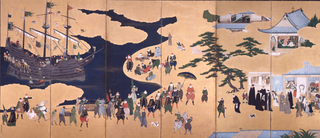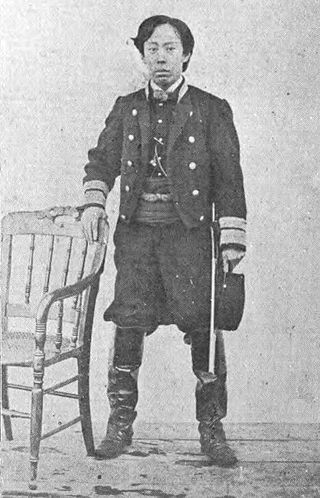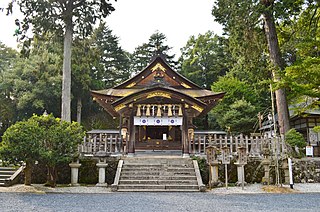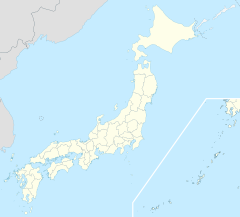
Emperor Go-Yōzei was the 107th Emperor of Japan, according to the traditional order of succession. Go-Yōzei's reign spanned the years 1586 through to his abdication in 1611, corresponding to the transition between the Azuchi–Momoyama period and the Edo period.

The Azuchi–Momoyama period was the final phase of the Sengoku period in Japanese history from 1568 to 1600.

Emperor Ōgimachi was the 106th Emperor of Japan, according to the traditional order of succession. He reigned from November 17, 1557, to his abdication on December 17, 1586, corresponding to the transition between the Sengoku period and the Azuchi–Momoyama period. His personal name was Michihito (方仁).

Nijō Castle is a flatland castle in Kyoto, Japan. The castle consists of two concentric rings (Kuruwa) of fortifications, the Ninomaru Palace, the ruins of the Honmaru Palace, various support buildings and several gardens. The surface area of the castle is 275,000 square metres, of which 8,000 square metres (86,000 sq ft) is occupied by buildings.

Fushimi is one of the eleven wards in the city of Kyoto, in Kyoto Prefecture, Japan. Famous places in Fushimi include the Fushimi Inari Shrine, with thousands of torii lining the paths up and down a mountain; Fushimi Castle, originally built by Toyotomi Hideyoshi, with its rebuilt towers and gold-lined tea-room; and the Teradaya, an inn at which Sakamoto Ryōma was attacked and injured about a year before his assassination. Also of note is the Gokōgu shrine, which houses a stone used in the construction of Fushimi Castle. The water in the shrine is particularly famous and it is recorded as one of Japan's 100 best clear water spots.

Fushimi Castle, also known as Momoyama Castle or Fushimi-Momoyama Castle, is a Japanese castle located in Fushimi Ward, Kyoto.

Keichō (慶長) was a Japanese era name after Bunroku and before Genna. This period spanned from October 1596 to July 1615. The reigning emperors were Go-Yōzei-tennō (後陽成天皇) and Go-Mizunoo-tennō (後水尾天皇).

Tenshō (天正) was a Japanese era name after Genki and before Bunroku. This period spanned the years from July 1573 through December 1592. The reigning emperors were Ōgimachi-tennō (正親町天皇) and Go-Yōzei-tennō (後陽成天皇).

Fushimi Inari-taisha is the head shrine of the kami Inari, located in Fushimi-ku, Kyoto, Kyoto Prefecture, Japan. The shrine sits at the base of a mountain also named Inari which is 233 metres (764 ft) above sea level, and includes trails up the mountain to many smaller shrines which span 4 kilometres (2.5 mi) and take approximately 2 hours to walk up.

Kitano Tenmangū is a Shinto shrine in Kamigyō-ku, Kyoto, Japan.

Nishi Hongan-ji (西本願寺) is a Jōdo Shinshū Buddhist temple in the Shimogyō ward of Kyoto, Japan. It serves as the head temple of the sub-sect Honganji-ha.

Kanō Naizen was a part of the Japanese family of painters, the Kanō school. He was the middle son of school's head Kanō Eitoku, younger brother to the Kano school heir Kanō Mitsunobu, older brother to Kanō Takanobu, and adopted brother to the famed Kanō school painter Kanō Sanraku. Naizen primarily worked with his fathers and brothers in the head Kanō workshop in Kyoto to restore many imperial buildings, Buddhist temples, and Shinto shrines that were destroyed during the Kamakura period and the Genpei Wars. In 1610–15 Naizen moved to Edo, the new administration capital, at the behest of the recently ascendent Tokugawa shogunate, Tokugawa Ieyasu.

Hōkō-ji is a temple in Kyoto, Japan, dating from the 16th century. Toyotomi Hideyoshi determined that the capital city should have a Daibutsu temple to surpass that of Nara. He is reputed to have claimed at the outset that he would complete construction in half the time it took Emperor Shōmu to complete the Great Buddha of Nara. The project during Emperor Shomū's reign took ten years. Hideyoshi would complete the initial phase of his project in only three years. The architects for this project were Nakamura Masakiyo and Heinouchi Yoshimasa.

The Kyoto Shoshidai was an important administrative and political office in the Tokugawa shogunate. The office was the personal representative of the military dictators Oda Nobunaga and Toyotomi Hideyoshi in Kyoto, the seat of the Japanese Emperor, and was adopted by the Tokugawa shōguns. The significance and effectiveness of the office is credited to the third Tokugawa shōgun, Tokugawa Iemitsu, who developed these initial creations as bureaucratic elements in a consistent and coherent whole.

Kanō Sanraku was a Japanese painter also known as Kimura Heizō, Shūri, Mitsuyori, and Sanraku. He was the sixth-generation member of the famous Kanō family of painters that served the Japanese shoguns. Sanraku's works combine the forceful quality of Momoyama work with the tranquil depiction of nature, and they have a more refined use of color typical of the Edo period.

Hiyoshi Taisha (日吉大社) is a Shinto shrine located in the city of Ōtsu, Shiga Prefecture Japan. This shrine is one of the Twenty-Two Shrines. Known before World War II as Hiei Taisha (日枝大社) or Hie jinja, "Hiyoshi" is now the preferred spelling. It was also known as the Sanno Gongen (山王権現). The head shrine in Ōtsu heads the seventh largest shrine network in Japan, with approximately 3800 Hiyoshi, Hie, and Sannō shrines nationwide. Torii of this shrine have a distinctive configuration, known as the "Sannō torii", with a gaggle above the main crossbeam. The 400,000 square meter precincts centered is designated as a National Historic Site, and the east and west main shrine buildings, the Nishi Hongū (西本宮) and Higashi Hongū (東本宮) are designated as National Treasures, and many of the structures in the precincts are designated as National Important Cultural Properties.

Sanbō-in is a Buddhist temple in southern Kyoto, Japan, known today primarily for the quality of its garden.

Hōkoku Shrine is a Shinto shrine located in Osaka, Japan. It is one of several Toyokuni shrines built in honor of Toyotomi Hideyoshi. It is part of the Osaka Castle Park.

Ube Jinja (宇倍神社) is a Shinto shrine in the Kokufu-cho neighborhood of the city of Tottori in Tottori Prefecture, Japan. It is the ichinomiya of former Inaba Province. The main festival of the shrine is held annually on April 21.























